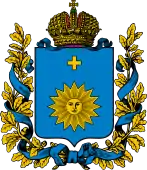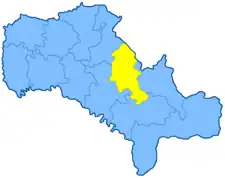Bratslav uezd
The Bratslav uezd[lower-alpha 1] was a county (uezd) of the Podolian Governorate of the Russian Empire. It bordered the Lipovets uezd of the Kiev Governorate to the north, the Gaysin uezd to the east, the Olgopol uezd to the south, the Yampol uezd to the southwest, and the Vinnitsa uezd to the north. The Bratslav uezd was eponymously named for its administrative center, Bratslav.
Bratslav uezd
Брацлавскій уѣздъ | |
|---|---|
 Coat of arms | |
 Location in the Podolia Governorate | |
| Country | Russian Empire |
| Krai | Southwestern |
| Governorate | Podolia |
| Established | 1797 |
| Abolished | 1923 |
| Capital | Bratslav |
| Area | |
| • Total | 3,079.93 km2 (1,189.17 sq mi) |
| Population (1897) | |
| • Total | 241,868 |
| • Density | 79/km2 (200/sq mi) |
| • Urban | 3.25% |
| • Rural | 96.75% |
Administrative divisions
The subcounties (volosts) of the Bratslav uezd in 1912 were as follows:[1]
| Name | Name in Russian | Capital |
|---|---|---|
| Zhuravlevka volost | Журавлевская волость | Zhuravlevka |
| Kleban volost | Клебанская волость | Kleban |
| Luka volost | Лучанская волость | Luka |
| Grabovtsy volost | Монастырская волость | Grabovtsy |
| Nemirov volost | Немировская волость | Nemirov |
| Obodnoe volost | Ободнянская волость | Obodnoe |
| Ruban volost | Рубанская волость | Ruban |
| Savintsy volost | Савинецкая волость | Savintsy |
| Trostyanets volost | Тростянецкая волость | Trostyanets |
| Kholodovka volost | Холодовская волость | Kholodovka |
| Shpikov volost | Шпиковская волость | Shpikov |
Demographics
At the time of the Russian Empire Census of 28 January [O.S. 15 January] 1897, the Bratslav uezd had a population of 241,868, including 120,261 men and 121,607 women. The majority of the population indicated Little Russian[lower-alpha 2] to be their mother tongue, with a significant Jewish speaking minority.[4]
| Language | Native speakers | Percentage |
|---|---|---|
| Little Russian[lower-alpha 2] | 199,859 | 82.63 |
| Jewish | 28,142 | 11.64 |
| Great Russian[lower-alpha 2] | 7,948 | 3.29 |
| Polish | 4,824 | 1.99 |
| Romanian | 331 | 0.14 |
| German | 284 | 0.12 |
| Tatar | 212 | 0.09 |
| Votyak | 65 | 0.03 |
| Czech | 54 | 0.02 |
| French | 47 | 0.02 |
| White Russian[lower-alpha 2] | 46 | 0.02 |
| Bashkir | 14 | 0.01 |
| Cheremis | 1 | 0.00 |
| Chuvash | 1 | 0.00 |
| Latvian | 1 | 0.00 |
| Mordovian | 1 | 0.00 |
| Other | 38 | 0.02 |
| Total | 241,868 | 100.00 |
Notes
- Prior to 1918, the Imperial Russian government classified Russians as the Great Russians, Ukrainians as the Little Russians, and Belarusians as the White Russians. After the creation of the Ukrainian People's Republic in 1918, the Little Russians identified themselves as "Ukrainian".[2] Also, the Belarusian Democratic Republic which the White Russians identified themselves as "Belarusian".[3]
References
- Волостныя, станичныя, сельския, гминныя правления и управления, а также полицейские станы всей России с обозначением места их нахождения [Volostny, stanichnaya, rural, communes of government and administration, as well as police camps throughout Russia with the designation of their location]. Kiev: Izd-vo T-va L. M. Fish. 1913. p. 161. Archived from the original on 2022-12-11.
- Hamm, Michael F. (2014). Kiev: A Portrait, 1800–1917. Princeton University Press. p. 83. ISBN 978-1-4008-5151-5.
- Fortson IV, Benjamin W. (2011). Indo-European Language and Culture: An Introduction. John Wiley & Sons. p. 429. ISBN 978-1-4443-5968-8.
- "Демоскоп Weekly - Приложение. Справочник статистических показателей". www.demoscope.ru. Retrieved 2019-12-19.